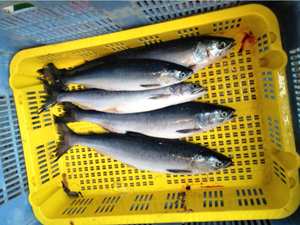International expedition answers troubling questions about B.C. salmon runs
The ocean is changing, but not to the benefit of sockeye, coho and chinook.
Randy Shore
Updated: October 30, 2019
Buried in the doom-and-gloom headlines about depleted salmon stocks and disastrous spawning returns is this nugget of truth: There are more salmon in the Pacific Ocean than at any time since 1925.
Russian fisheries will harvest 460,000 metric tonnes of chum and pink salmon this year, about 20 times Canada’s total haul of all five Pacific salmon species.
But the headlines aren’t necessarily wrong. The ocean is changing, just not to the benefit of the species prized in B.C., such as sockeye, coho and chinook.
The reappearance of “The Blob” — a huge mass of warm water stretching from California to Alaska — could complicate their lives further. During its last appearance in 2014, millions of fish and seabirds perished.
The Russian research vessel Kaganovsky set out on a five-week grid-search test fishery in the North Pacific last February with a team of 21 scientists from Canada, Russia, the United States, Korea and Japan. They examined specific questions about the range, feeding habits and condition of adult salmon, and at least some of the answers are trickling in.
But expedition organizer Dick Beamish is now pressing hard to get a second expedition ready, so they don’t miss an opportunity to study the effects of The Blob firsthand.
He is also convinced that ocean-based stock assessments should be completed every year to accurately estimate salmon returns and manage fisheries, a model used with success by the Russians.
“Historically, we have based our understanding of salmon on what we know about them when they leave fresh water and how many come back to spawn,” said Beamish.
Some of the elusive pink salmon caught during an international research voyage on the Russian vessel Kaganovsky. Chrys Neville / PNG
But salmon spend between one and four winters in the open ocean, depending on the species, and what happens to them during that time is anyone’s guess.
Good conditions and the availability of food for juvenile salmon in near-shore rearing areas is believed to be especially important for the ability of Fraser River salmon to survive their first winter, which appears to be borne out in preliminary data from the first expedition.
“We had guessed that the major mortality for salmon comes in their first ocean winter, and the abundance at that point gives you an idea of what kind of returns you can expect in the future,” he explained.
Fisheries and Oceans Canada had predicted about five million Fraser River sockeye would return in 2019, but only 600,000 made it.
“We had made an estimate of the number at about 870,000, so we were much more accurate,” said Beamish. “We didn’t catch that many fish in the survey, but it was over a large enough area that we knew what to expect.”
Based on the test fisheries, Beamish expects the 2020 sockeye return will be equally dismal, although he is cautious about predictions based on a single survey.
Beamish is making the rounds to foundations and corporate donors to raise $1.5 million for the second survey, which he hopes will sail early next year.
The B.C. Salmon and Restoration and Innovation Fund has already promised $650,000 and the Pacific Salmon Foundation has pledged $300,000.
rshore@postmedia.com




